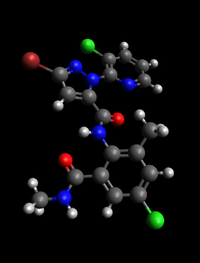Chemistry:Chlorantraniliprole

| |
 Chlorantraniliprole 3D molecular model generated using Avogadro software
| |
| Names | |
|---|---|
| Preferred IUPAC name
3-Bromo-N-[4-chloro-2-methyl-6-(methylcarbamoyl)phenyl]-1-(3-chloropyridin-2-yl)-1H-pyrazole-5-carboxamide | |
| Other names
Rynaxypyr, Coragen, Altacor
| |
| Identifiers | |
3D model (JSmol)
|
|
| ChEBI | |
| ChEMBL | |
| EC Number |
|
| KEGG | |
PubChem CID
|
|
| UNII | |
| |
| |
| Properties | |
| C18H14BrCl2N5O2 | |
| Molar mass | 483.15 g·mol−1 |
| Melting point | 209 °C (408 °F; 482 K) |
| Hazards | |
| GHS pictograms |  
|
| GHS Signal word | Warning |
| H319, H335, H410 | |
| P261, P264, P271, P273, P280, P304+340, P305+351+338, P312, P337+313, P391, P403+233, P405, P501 | |
Except where otherwise noted, data are given for materials in their standard state (at 25 °C [77 °F], 100 kPa). | |
| Infobox references | |
Chlorantraniliprole (Rynaxypyr) is an insecticide of the ryanoid classes.[1] Chlorantraniliprole was developed world-wide by DuPont and belongs to a class of selective insecticides featuring a novel mode of action to control a range of pests belonging to the order Lepidoptera (moth), and some Coleoptera (beetle), Diptera (fly), and Isoptera (termite) species.
Chlorantraniliprole opens muscular calcium channels, in particular the ryanodine receptor, rapidly causing paralysis and ultimately death of sensitive species. The differential selectivity chlorantraniliprole has towards insect ryanodine receptors explains the outstanding profile of low mammalian toxicity.[citation needed] Chlorantraniliprole is active on chewing pest insects primarily by ingestion and secondarily by contact.
Chlorantraniliprole is an active ingredient in the insecticidal products Ferterra (0.4% chlorantraniliprole), Scotts GrubEx1 (0.8% chlorantraniliprole), and Coragen (18.5% chlorantraniliprole).
References
 |

